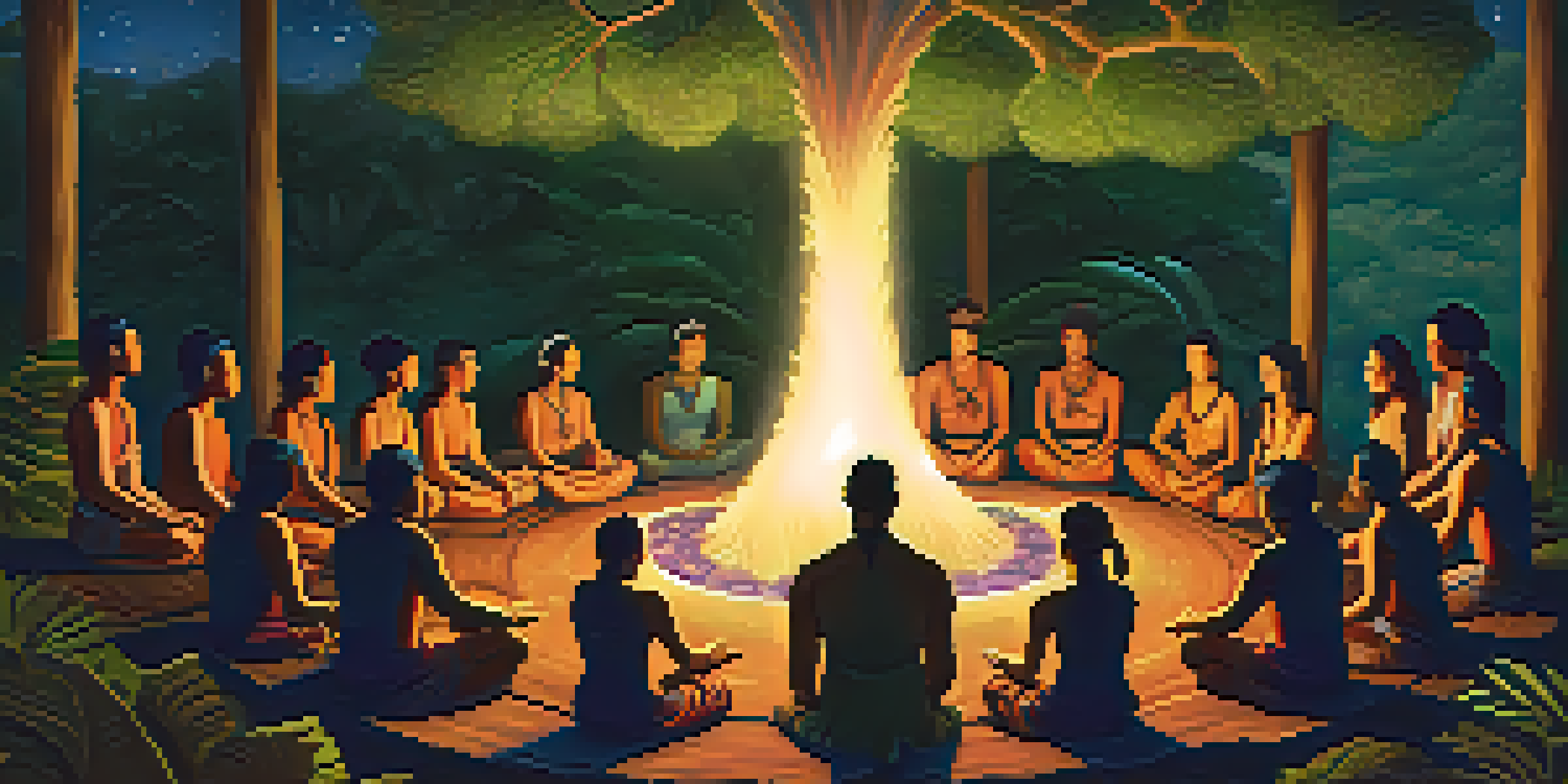The Role of Personal Responsibility During Ayahuasca Ceremonies

What is Ayahuasca and Its Cultural Significance?
Ayahuasca is a traditional Amazonian brew made from the Banisteriopsis caapi vine and other plants. It has been used for centuries by indigenous communities for spiritual healing and connection to the divine. This powerful concoction induces altered states of consciousness, allowing participants to explore their inner selves and gain insights into their lives.
The greatest discovery of my generation is that a human being can alter his life by altering his attitude.
Understanding the cultural context of Ayahuasca is essential, as it emphasizes the importance of respect and intention. Many ceremonies are steeped in ritual, guided by experienced shamans who facilitate the experience. This cultural backdrop sets the stage for participants to engage meaningfully and take personal responsibility for their journey.
As Ayahuasca gains popularity worldwide, it’s crucial to approach it with the same respect as those who have practiced it for generations. This means recognizing that personal responsibility is not just about understanding the drug but also about honoring the traditions and teachings that come with it.
The Importance of Setting Intentions
Setting a clear intention is a fundamental aspect of any Ayahuasca ceremony. Intentions serve as a personal compass, guiding your experience and helping you focus on what you hope to learn or heal. Without a defined intention, participants may find themselves adrift, unsure of their purpose during the ceremony.

For example, someone seeking clarity on a major life decision might set an intention to gain insight into their choices. This conscious decision shapes their experience, allowing them to process emotions and thoughts related to that decision. When participants take responsibility for their intentions, they create a more meaningful and transformative experience.
Cultural Significance of Ayahuasca
Ayahuasca is a traditional Amazonian brew used for spiritual healing, emphasizing respect and intention in its cultural practices.
Moreover, intentions can evolve during the ceremony, reflecting the insights gained along the way. Being open to this evolution while maintaining a sense of personal responsibility can lead to powerful revelations, turning the experience into a profound journey of self-discovery.
Creating a Safe and Supportive Environment
Personal responsibility extends beyond individual intentions; it also encompasses the environment in which the ceremony takes place. A safe and supportive setting is vital for participants to feel comfortable and open to the experience. This safety often hinges on the collective responsibility of everyone involved, from the facilitators to the attendees.
The mind is everything. What you think you become.
For instance, a respectful and attentive group can foster a space where individuals feel free to express themselves. This mutual support enables participants to explore their vulnerabilities without fear of judgment. When everyone takes responsibility for maintaining a positive atmosphere, the overall energy of the ceremony enhances the healing potential of Ayahuasca.
Additionally, participants should communicate their needs and boundaries during the ceremony. This proactive approach not only contributes to personal well-being but also encourages others to do the same, creating a ripple effect of responsibility and care throughout the group.
Understanding the Physical and Emotional Risks
Participating in an Ayahuasca ceremony involves more than just spiritual exploration; it also carries physical and emotional risks. The brew can induce intense physical reactions, including vomiting and diarrhea, which are often considered part of the purging process. Being aware of these risks is a key aspect of personal responsibility.
Emotionally, Ayahuasca can bring up deep-seated traumas and unresolved issues, challenging participants to confront their past. This process can be overwhelming, making it crucial for individuals to prepare mentally and emotionally before engaging in a ceremony. Understanding these risks allows participants to take proactive measures, such as discussing concerns with facilitators or opting out if they feel unprepared.
The Importance of Setting Intentions
Setting clear intentions is essential for guiding the Ayahuasca experience, allowing participants to focus on personal growth and healing.
Ultimately, acknowledging these potential challenges empowers participants to take charge of their experience. By being informed and prepared, individuals can navigate the sometimes tumultuous waters of an Ayahuasca journey with greater confidence and resilience.
Integration: The Key to Lasting Change
The journey doesn’t end when the Ayahuasca ceremony concludes; in fact, that’s just the beginning. Integration is the process of making sense of the insights gained during the experience and applying them to everyday life. This step is crucial for ensuring that the lessons learned translate into lasting change.
Taking personal responsibility during integration means actively engaging with your experiences and feelings. This could involve journaling, talking with a trusted friend, or seeking guidance from a therapist. By actively processing the experience, participants can better understand what it means for their lives moving forward.
Integration groups are becoming popular as a way to share experiences with others who have undergone similar journeys. These supportive spaces foster accountability and community, allowing participants to explore their insights in a nurturing environment, reinforcing the importance of personal responsibility in ongoing healing.
Respecting the Sacredness of the Experience
Ayahuasca ceremonies are often seen as sacred rituals, steeped in tradition and spirituality. Recognizing this sacredness is an essential aspect of personal responsibility during the experience. Participants should approach the ceremony with reverence, understanding that they are partaking in a practice that has deep cultural roots.
This respect can manifest in various ways, such as adhering to the guidelines set by the facilitators and honoring the traditions associated with the ceremony. It’s crucial to understand that the experience isn’t just about personal gain; it’s about connecting with something greater than oneself.
Role of Aftercare in Healing Journey
Aftercare is crucial for processing experiences post-ceremony, reinforcing insights and fostering a sense of community among participants.
By embodying this respect, participants not only enhance their own experience but also honor the lineage of knowledge and healing passed down through generations. This collective acknowledgment fosters a deeper connection to the ceremony and reinforces the importance of personal responsibility within the larger context of the communal experience.
The Role of Aftercare in Personal Responsibility
Aftercare is a critical but often overlooked component of the Ayahuasca journey. It refers to the support and care provided to participants post-ceremony, helping them process their experiences and emotions. Taking responsibility for one's well-being after the ceremony can significantly impact the overall effectiveness of the journey.
For instance, aftercare can include seeking out community support, participating in follow-up sessions with facilitators, or even engaging in self-care practices like meditation and relaxation. By actively investing in their aftercare, participants can reinforce the insights gained during the ceremony and promote emotional healing.

Additionally, discussing experiences with fellow participants can provide valuable perspective and foster a sense of community. This sense of connection can be instrumental in the healing process, showing how personal responsibility extends beyond the individual to encompass communal support and shared journeys.